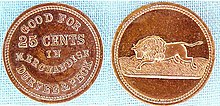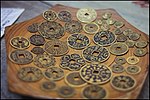
Numismatics is the study or collection of currency, including coins, tokens, paper money, medals and related objects.

A scrip is any substitute for legal tender. It is often a form of credit. Scrips have been created and used for a variety of reasons, including exploitative payment of employees under truck systems; or for use in local commerce at times when regular currency was unavailable, for example in remote coal towns, military bases, ships on long voyages, or occupied countries in wartime. Besides company scrip, other forms of scrip include land scrip, vouchers, token coins such as subway tokens, IOUs, arcade tokens and tickets, and points on some credit cards.

Token money, or token, is a form of money that has a lesser intrinsic value compared to its face value. Token money is anything that is accepted as money, not due to its intrinsic value but instead because of custom or legal enactment. Token money costs less to produce than its face value. A banknote, e.g. a five-pound note, is token money because despite its value being 5 pounds it only costs significantly less to produce. A gold coin is not considered token money. The Token money system has been adopted in many businesses around the world as an effective way to exchange value between companies and customers. Token money as a system is predominantly used in mobile games, but is also used in the realm of e-commerce. Token money is similar to fiat money which also has little intrinsic value, however they differ in that token money is a limited legal tender. The adoption of token money has improved transaction efficiency, as the practicalty of transacting with sums of gold poses a larger security risk. In a commodity economy, money is a measure of the value of goods and services (prices) within a sovereign country or the same economy, as well as a particular commodity to pay off debts. The token is also used as a medium of exchange, as a store of value, and as a unit of account. Digital currencies using decentralized blockchain technology are also a form of token money.

Canadian Tire money, officially Canadian Tire 'money' or CTM, is a loyalty program operated by the Canadian retail chain Canadian Tire Corporation (CTC). It consists of both paper coupons introduced in 1958 and used in Canadian Tire stores as scrip, and since 2012 in a digital form introduced as Canadian Tire Money Advantage, rebranded in 2018 as Triangle Rewards. Both forms of the loyalty program remain current as of December 2022. Canadian Tire Money has been noted as the most successful loyalty program in Canadian retail history.
This glossary of numismatics is a list of definitions of terms and concepts relevant to numismatics and coin collecting, as well as sub-fields and related disciplines, with concise explanations for the beginner or professional.

In numismatics, token coins or trade tokens are coin-like objects used instead of coins. The field of token coins is part of exonumia and token coins are token money. Their denomination is shown or implied by size, color or shape. They are often made of cheaper metals like copper, pewter, aluminium, brass and tin, or non-metals like bakelite, leather and porcelain.

The Rupie was the currency of German East Africa between 1890 and 1916, continuing to circulate in the Tanganyika Territory until 1920.

The Cook Islands dollar was the former currency of the Cook Islands, which now uses the New Zealand dollar, although some physical cash issued for the Cook Islands dollar remains in use. The dollar was subdivided into 100 cents, with some older 50-cent coins carrying the denomination as "50 tene".

Canada has an extensive history with regard to its currencies. Prior to European contact, indigenous peoples in Canada used items such as wampum and furs for trading purposes, which continued when trade with Europeans began. During the period of French colonization, coins were introduced, as well as one of the first examples of paper currency by a western government. During the period of British colonization, additional coinage was introduced, as well as banknotes. The Canadian colonies gradually moved away from the British pound and adopted currencies linked to the United States dollar. With Confederation in 1867, the Canadian dollar was established. By the mid-20th century, the Bank of Canada was the sole issuer of paper currency, and banks ceased to issue banknotes.
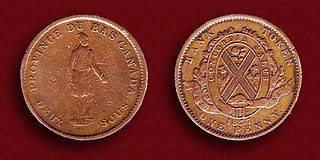
The pound was the currency of the Canadas until 1858. It was subdivided into 20 shillings (s), each of 12 pence (d). In Lower Canada, the sou was used, equivalent to a halfpenny. Although the £sd accounting system had its origins in sterling, the Canadian pound was never at par with sterling's pound.
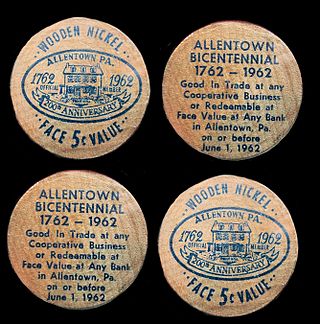
In the United States, a wooden nickel is a wooden token coin, usually issued by a merchant or bank as a promotion, sometimes redeemable for a specific item such as a drink.

Promotional fake United States currency is fantasy "currency", adapted from United States currency that makes no assertion of being legal tender and is often created by individuals as a way to promote practical jokes, or social statements. It is legal to print so long as it makes no assertion, whether by appearance or statement, of authenticity. Promotional United States fake currency is not to be confused with counterfeit currency or conflated with legitimate currency that has been demonetized.
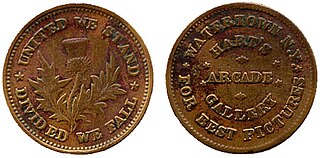
Civil War tokens are token coins that were privately minted and distributed in the United States between 1861 and 1864. They were used mainly in the Northeast and Midwest. The widespread use of the tokens was a result of the scarcity of government-issued cents during the Civil War.
The history of currency in the British colony of Saint Vincent closely follows that of the British Eastern Caribbean territories in general. As such, it should not be considered in isolation. In order to get a broad overview of currency in the region, see the article British West Indies dollar.

Japanese invasion money, officially known as Southern Development Bank Notes, was currency issued by the Japanese Military Authority, as a replacement for local currency after the conquest of colonies and other states in World War II.

Hard Times Tokens are American large or half cent-sized copper or brass tokens, struck from about 1833 through 1843, serving as unofficial currency. These privately made pieces, comprising merchant, political and satirical pieces, were used during a time of political and financial crisis in the United States.

The National Numismatic Collection is the national coin cabinet of the United States. The collection is part of the Smithsonian Institution's National Museum of American History.
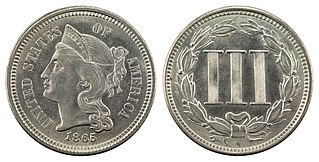
The copper-nickel three-cent piece, often called a three-cent nickel piece or three-cent nickel, was designed by US Mint Chief Engraver James B. Longacre and struck by the United States Bureau of the Mint from 1865 to 1889. It was initially popular, but its place in commerce was supplanted by the five-cent piece, or nickel.
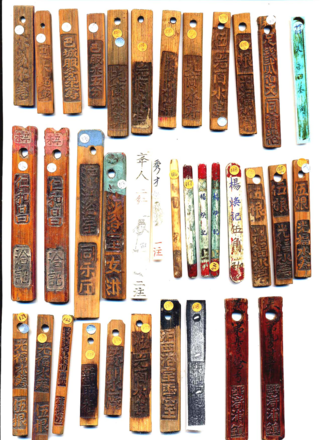
Bamboo tallies, alternatively known as bamboo tokens or bamboo money, were a type of alternative currency that was produced in Eastern China from the 1870s until the 1940s and were used to supplement Chinese cash coins and other small denomination Chinese currencies in a manner similar to paper money. Some bamboo tallies were issued in denominations of wén (文) or "strings of cash coins" (串), some bamboo tallies were denominated in qián (錢), tóngyuán, jiǎo (角), and yáng, other than in money bamboo tallies could also be denominated in tea bags. During the same time as bamboo tallies were issued other local businesses manufactured paper money denominated in fēn (分) while others used either copper tokens or money made from bones in a similar fashion.
Meiji Tsūhō (明治通宝) refers to the first paper currency that was issued by the Imperial Japanese government during the early Meiji era. After the "yen" was officially adopted in 1871, the Japanese looked to the Western World for their improved paper currency technology. An agreement was made with Italian engraver Edoardo Chiossone, who designed 6 denominations of Yen, and 3 denominations of Sen. The Japanese Government's decision to issue these notes as fiat currency ended in disaster as inflation rose following the Satsuma Rebellion. Meiji Tsūhō notes were ultimately demonetized towards the end of the 19th century.





